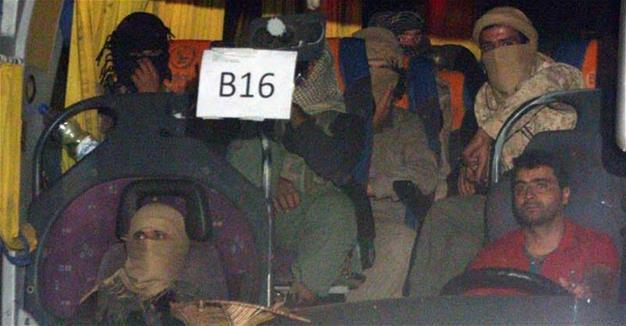US-led strike in Syria blocks ISIL fighters evacuated from Lebanon

The U.S.-led coalition carried out two sets of air strikes on Aug. 30 to block Islamic State of Iraq and the Levant (ISIL) group fighters evacuated from Lebanon from reaching eastern Syria, its spokesman told AFP.
Hundreds of ISIL fighters and civilians were evacuated on Aug. 28 from the border region between Lebanon and Syria under a ceasefire deal and were headed to an ISIL-held town near Syria's eastern frontier with Iraq.
A first set of strikes hit the road leading from the Syrian town of Hmaymah to the ISIL-held town of Albukamal further east, said coalition spokesman Colonel Ryan Dillon.
“To prevent the convoy from moving further east, we cratered the road and destroyed a small bridge," he told AFP.
The coalition then carried out a second set of strikes that "struck individual vehicles and fighters that were clearly identified as ISIL" and appeared to be moving towards the convoy from Albukamal.
"If they continue to try to send people that way, then we'll continue to strike them. It could be a running tally," Dillon said.
“ISIL is a global threat; relocating terrorists from one place to another for someone else to deal with is not a lasting solution."
The evacuation deal was negotiated between ISIL and powerful Lebanese Shiite movement Hezbollah, which has intervened in the war in neighbouring Syria to prop up the Damascus government.
Hezbollah fought a week-long offensive against ISIL on the Syrian side of the Lebanese border, coinciding with a simultaneous assault by Lebanese troops on their side of the frontier.
The battles ended on Aug. 27 with the announcement of the deal to bus ISIL forces hundreds of kilometres from Syria's western border with Lebanon to its eastern frontier with Iraq.
Jihadists and civilians, including children, left the border region two days ago, but on Aug. 30 their buses were still held up at Hmaymah.
The Syrian Observatory for Human Rights said the convoy was looking for a "new route" to reach Albukamal after the coalition strike.
Dillon said the U.S.-led alliance was monitoring the convoy in real time and its last known location was near Hmaymah.
"If we are able to strike them without harming civilians, then we will do so," Dillon said.
Asked whether the presence of civilians had prompted the coalition to bomb the road instead of the convoy itself, Dillon said that would be "consistent" with protocol.
The evacuation agreement had sparked a furious reaction from the United States, which considers Hezbollah to be a "terrorist" organisation.
It was also met with outrage in Iraq, with Prime Minister Haider al-Abadi describing it as "unacceptable" and an "insult to the Iraqi people.”
Hezbollah chief Hassan Nasrallah issued a rare written statement late Aug. 30 in an attempt to tamp down the controversy.
"We transferred these defeated fighters from a front where we are battling to another front where we are battling," he said.
"Our fight and our fate are one," Nasrallah said, addressing Iraqi officials.
Meanwhile, a commander in the pro-Syrian government military alliance said on Aug. 31 that the ISIL evacuation convoy will head from government-held Sukhna towards the ISIL-held Deir al-Zor region.
The commander said the location for the convoy to move into ISIL-held territory had been changed from Humeima in the southeast to Sukhna, further north, and that part of the deal was already moving forward.
He said an exchange had begun in the desert, under which the bodies of an Iranian killed in the fighting and two other dead fighters would be swapped for 25 wounded ISIL fighters.
Lebanese opponents to the deal were angry that ISIL fighters were travelling "on air-conditioned buses" after having been suspected of killing Lebanese troops.
 The U.S.-led coalition carried out two sets of air strikes on Aug. 30 to block Islamic State of Iraq and the Levant (ISIL) group fighters evacuated from Lebanon from reaching eastern Syria, its spokesman told AFP.
The U.S.-led coalition carried out two sets of air strikes on Aug. 30 to block Islamic State of Iraq and the Levant (ISIL) group fighters evacuated from Lebanon from reaching eastern Syria, its spokesman told AFP.